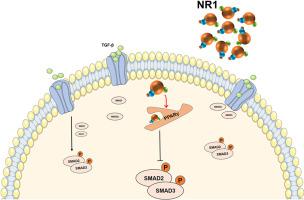当前位置:
X-MOL 学术
›
Exp. Cell Res.
›
论文详情
Our official English website, www.x-mol.net, welcomes your
feedback! (Note: you will need to create a separate account there.)
Notoginsenoside R1 targets PPAR-γ to inhibit hepatic stellate cell activation and ameliorates liver fibrosis
Experimental Cell Research ( IF 3.3 ) Pub Date : 2024-03-16 , DOI: 10.1016/j.yexcr.2024.113992 Cheng Guo 1 , Linying Lai 2 , Boyu Ma 2 , Qian Huang 3 , Zhirong Wang 2
Experimental Cell Research ( IF 3.3 ) Pub Date : 2024-03-16 , DOI: 10.1016/j.yexcr.2024.113992 Cheng Guo 1 , Linying Lai 2 , Boyu Ma 2 , Qian Huang 3 , Zhirong Wang 2
Affiliation

|
Hepatic fibrosis, a common pathological process that occurs in end-stage liver diseases, is a serious public health problem and lacks effective therapy. Notoginsenoside R1 (NR1) is a small molecule derived from the traditional Chinese medicine Sanqi, exhibiting great potential in treating diverse metabolie disorders. Here we aimed to enquired the role of NR1 in liver fibrosis and its underlying mechanism in hepatoprotective effects. We investigated the anti-fibrosis effect of NR1 using CCl-induced mouse mode of liver fibrosis as well as TGF-β1-activated JS-1, LX-2 cells and primary hepatic stellate cell. Cell samples treated by NR1 were collected for transcriptomic profiling analysis. PPAR-γ mediated TGF-β1/Smads signaling was examined using PPAR-γ selective inhibitors and agonists intervention, immunofluorescence staining and western blot analysis. Additionally, we designed and studied the binding of NR1 to PPAR-γ using molecular docking. NR1 obviously attenuated liver histological damage, reduced serum ALT, AST levels, and decreased liver fibrogenesis markers in mouse mode. Mechanistically, NR1 elevated PPAR-γ and decreased TGF-β1, -Smad2/3 expression. The TGF-β1/Smads signaling pathway and fibrotic phenotype were altered in JS-1 cells after using PPAR-γ selective inhibitors and agonists respectively, confirming PPAR-γ played a pivotal protection role inNR1 treating liver fibrosis. Further molecular docking indicated NR1 had a strong binding tendency to PPAR-γ with minimum free energy. NR1 attenuates hepatic stellate cell activation and hepatic fibrosis by elevating PPAR-γ to inhibit TGF-β1/Smads signalling. NR1 may be a potential candidate compound for reliving liver fibrosis.
中文翻译:

三七皂苷R1靶向PPAR-γ抑制肝星状细胞活化并改善肝纤维化
肝纤维化是终末期肝病常见的病理过程,是一个严重的公共卫生问题,缺乏有效的治疗方法。三七皂苷 R1 (NR1) 是一种源自中药三七的小分子,在治疗多种代谢紊乱方面具有巨大潜力。本研究旨在探讨NR1在肝纤维化中的作用及其保肝作用的机制。我们使用 CCl 诱导的小鼠肝纤维化模型以及 TGF-β1 激活的 JS-1、LX-2 细胞和原代肝星状细胞研究了 NR1 的抗纤维化作用。收集经 NR1 处理的细胞样本进行转录组分析。使用 PPAR-γ 选择性抑制剂和激动剂干预、免疫荧光染色和蛋白质印迹分析来检查 PPAR-γ 介导的 TGF-β1/Smads 信号传导。此外,我们利用分子对接设计并研究了 NR1 与 PPAR-γ 的结合。在小鼠模型中,NR1 明显减轻了肝脏组织学损伤,降低了血清 ALT、AST 水平,并降低了肝纤维化标志物。从机制上讲,NR1 升高 PPAR-γ 并降低 TGF-β1、-Smad2/3 的表达。分别使用PPAR-γ选择性抑制剂和激动剂后,JS-1细胞中TGF-β1/Smads信号通路和纤维化表型发生改变,证实PPAR-γ在NR1治疗肝纤维化中发挥着关键的保护作用。进一步的分子对接表明NR1以最小的自由能与PPAR-γ有很强的结合倾向。 NR1 通过升高 PPAR-γ 抑制 TGF-β1/Smads 信号传导来减弱肝星状细胞活化和肝纤维化。 NR1可能是缓解肝纤维化的潜在候选化合物。
更新日期:2024-03-16
中文翻译:

三七皂苷R1靶向PPAR-γ抑制肝星状细胞活化并改善肝纤维化
肝纤维化是终末期肝病常见的病理过程,是一个严重的公共卫生问题,缺乏有效的治疗方法。三七皂苷 R1 (NR1) 是一种源自中药三七的小分子,在治疗多种代谢紊乱方面具有巨大潜力。本研究旨在探讨NR1在肝纤维化中的作用及其保肝作用的机制。我们使用 CCl 诱导的小鼠肝纤维化模型以及 TGF-β1 激活的 JS-1、LX-2 细胞和原代肝星状细胞研究了 NR1 的抗纤维化作用。收集经 NR1 处理的细胞样本进行转录组分析。使用 PPAR-γ 选择性抑制剂和激动剂干预、免疫荧光染色和蛋白质印迹分析来检查 PPAR-γ 介导的 TGF-β1/Smads 信号传导。此外,我们利用分子对接设计并研究了 NR1 与 PPAR-γ 的结合。在小鼠模型中,NR1 明显减轻了肝脏组织学损伤,降低了血清 ALT、AST 水平,并降低了肝纤维化标志物。从机制上讲,NR1 升高 PPAR-γ 并降低 TGF-β1、-Smad2/3 的表达。分别使用PPAR-γ选择性抑制剂和激动剂后,JS-1细胞中TGF-β1/Smads信号通路和纤维化表型发生改变,证实PPAR-γ在NR1治疗肝纤维化中发挥着关键的保护作用。进一步的分子对接表明NR1以最小的自由能与PPAR-γ有很强的结合倾向。 NR1 通过升高 PPAR-γ 抑制 TGF-β1/Smads 信号传导来减弱肝星状细胞活化和肝纤维化。 NR1可能是缓解肝纤维化的潜在候选化合物。











































 京公网安备 11010802027423号
京公网安备 11010802027423号